A Low-Profile and Ultra-Wideband Pancharatnam–Berry Coding Metasurface for High-Efficiency and Wide-Angle Circular Polarization Anomalous Reflection
Abstract
1. Introduction
2. Method and Design
3. Design and Simulation
4. Optimization of Coding Metasurface
5. Experimental Verification
6. Conclusions
Author Contributions
Funding
Informed Consent Statement
Data Availability Statement
Conflicts of Interest
References
- Wan, X.; Huang, Z.A.; Wang, J.W.; Wang, W.H.; Li, B.Y.; Xiao, Q.; Wang, X.J.; Wan, J.C.; Cui, T.J. Information Metasurface for Electromagnetic Sensing and Wireless Communications. Adv. Mater. Technol. 2024, 9, 2301629. [Google Scholar] [CrossRef]
- Ma, H.; Chen, T.; Liu, L.; Yang, J.; Qiao, Y.; Yang, S.; Liu, Y.; Duan, J.; Xiong, W.; Deng, L. Tunable Stealth Metasurface via Dual Geometric Phase Modulation. Adv. Opt. Mater. 2024, 12, 2301898. [Google Scholar] [CrossRef]
- Yin, T.; Ren, J.; Zhang, B.; Li, P.C.; Luan, Y.C.; Yin, Y.Z. Reconfigurable Transmission-Reflection-Integrated Coding Metasurface for Full-Space Electromagnetic Wavefront Manipulation. Adv. Opt. Mater. 2024, 12, 2301326. [Google Scholar] [CrossRef]
- Tian, H.W.; Zhang, X.G.; Jiang, W.X.; Li, X.; Liu, Y.K.; Qiu, C.; Cui, T.J. Programmable Controlling of Multiple Spatial Harmonics via a Nonlinearly-Phased Grating Metasurface. Adv. Funct. Mater. 2022, 32, 2203120. [Google Scholar] [CrossRef]
- Dong, L.; Li, X.S.; Zhu, L.; Burokur, S.N.; Wu, Q.; Ding, X.M. Full-Space Double-Layer Patterned 2-Bit Coding Metasurface Hologram. Ann. Der Phys. 2022, 534, 2200229. [Google Scholar] [CrossRef]
- Xue, C.; Sun, J.; Gao, X.; Chen, F.; Pang, Z.; Lou, Q.; Chen, Z.N. An Ultrathin, Low-Profile and High-Efficiency Metalens Antenna Based on Chain Huygens Metasurface. IEEE Trans. Antennas Propag. 2022, 70, 11442–11453. [Google Scholar] [CrossRef]
- Li, C.; Zheng, Z.; Ke, L.; Fang, B.; Hong, Z.; Yu, M.; Jing, X. Terahertz vector beams generated by rectangular multilayer transmission metasurface. Opt. Laser Technol. 2024, 169, 110143. [Google Scholar] [CrossRef]
- Malleboina, R.; Dash, J.C.; Sarkar, D. Design of Anomalous Reflectors by Phase Gradient Unit Cell-Based Digitally Coded Metasurface. IEEE Antennas Wirel. Propag. Lett. 2023, 22, 2305–2309. [Google Scholar] [CrossRef]
- Zhou, Y.; Zhang, G.; Chen, H.; Zhou, P.; Wang, X.; Zhang, L.; Zhang, L.; Xie, J.; Deng, L. Design of Phase Gradient Coding Metasurfaces for Broadband Wave Modulating. Sci. Rep. 2018, 8, 8672. [Google Scholar] [CrossRef]
- Vuyyuru, S.K.R.; Valkonen, R.; Kwon, D.; Tretyakov, S.A. Efficient Anomalous Reflector Design Using Array Antenna Scattering Synthesis. IEEE Antennas Wirel. Propag. Lett. 2023, 22, 1711–1715. [Google Scholar] [CrossRef]
- Fu, X.; Shi, L.; Yang, J.; Fu, Y.; Liu, C.; Wu, J.W.; Yang, F.; Bao, L.; Cui, T.J. Flexible Terahertz Beam Manipulations Based on Liquid-Crystal-Integrated Programmable Metasurfaces. Acs Appl. Mater. Interfaces 2022, 14, 22287–22294. [Google Scholar] [CrossRef] [PubMed]
- Liu, C.; He, J.; Zhou, J.; Xu, J.; Bi, K.; Chen, J.; Qiao, L.; Bai, Y. Broadband, High-Efficiency and Wide-Incident-Angle Anomalous Reflection in Groove Metagratings. Ann. Der Phys. 2021, 533, 2100149. [Google Scholar] [CrossRef]
- Jing, H.B.; Ma, Q.; Bai, G.D.; Cui, T.J. Anomalously Perfect Reflections Based on 3-Bit Coding Metasurfaces. Adv. Opt. Mater. 2019, 7, 1801742. [Google Scholar] [CrossRef]
- Sun, S.; Ma, H.F.; Chen, Y.T.; Cui, T.J. Transmission-Reflection-Integrated Metasurface with Simultaneous Amplitude and Phase Controls of Circularly Polarized Waves in Full Space. Laser Photonics Rev. 2024, 8, 2300945. [Google Scholar] [CrossRef]
- Liao, W.J.; Yeh, J.T.; Chang, S.H. Circularly Polarized Chip Antenna Design for GPS Reception on Handsets. IEEE Trans. Antennas Propag. 2014, 62, 3482–3489. [Google Scholar] [CrossRef]
- Mazanov, M.; Yermakov, O.; Deriy, I.; Takayama, O.; Bogdanov, A.; Lavrinenko, A.V. Photonic Spin Hall Effect: Contribution of Polarization Mixing Caused by Anisotropy. Quantum Rep. 2020, 2, 489–500. [Google Scholar] [CrossRef]
- Cai, L.; Zhang, S.; Zhu, W.; Wu, H.; Zheng, H.; Yu, J.; Zhong, Y.; Chen, Z. Photonic spin Hall effect by anisotropy-induced polarization gradient in momentum space. Opt. Lett. 2020, 45, 6740–6743. [Google Scholar] [CrossRef] [PubMed]
- Gou, Y.; Ma, H.F.; Wu, L.W.; Wang, Z.X.; Xu, P.; Cui, T.J. Broadband Spin-Selective Wavefront Manipulations Based on Pancharatnam-Berry Coding Metasurfaces. Acs Omega 2021, 6, 30019–30026. [Google Scholar] [CrossRef]
- Gao, H.H.; Huang, X.J.; Ma, X.W.; Li, X.Y.; Guo, L.Y.; Yang, H.L. An ultra-wideband coding polarizer for beam control and RCS reduction. Front. Phys. 2023, 18, 42301. [Google Scholar] [CrossRef]
- Han, J.; Cao, X.; Gao, J.; Li, S.; Yang, H.; Zhang, C.; Li, T. Broadband dual-circular polarized coding metasurfaces and their powerful manipulation of differently circular polarizations. Opt. Express 2019, 27, 34142–34154. [Google Scholar] [CrossRef]
- Li, S.; Dong, S.; Yi, S.; Pan, W.; Chen, Y.; Guan, F.; Guo, H.; Wang, Z.; He, Q.; Zhou, L.; et al. Broadband and high-efficiency spin-polarized wave engineering with PB metasurfaces. Opt. Express 2020, 28, 15601–15610. [Google Scholar] [CrossRef] [PubMed]
- Yang, D.R.; Cheng, Y.Z.; Luo, H.; Chen, F.; Wu, L. Ultrathin and Ultra-Broadband Terahertz Single-Layer Metasurface Based on Double-Arrow-Shaped Resonator Structure for Full-Space Wavefront Manipulation. Adv. Theory Simul. 2023, 6, 2300162. [Google Scholar] [CrossRef]
- Wong, A.M.H.; Eleftheriades, G.V. Perfect Anomalous Reflection with a Bipartite Huygens’ Metasurface. Phys. Rev. X 2018, 8, 011036. [Google Scholar] [CrossRef]
- Chen, M.; Kim, M.; Wong, A.M.H.; Eleftheriades, G.V. Huygens’ metasurfaces from microwaves to optics: A review. Nanophotonics 2018, 7, 1207–1231. [Google Scholar] [CrossRef]
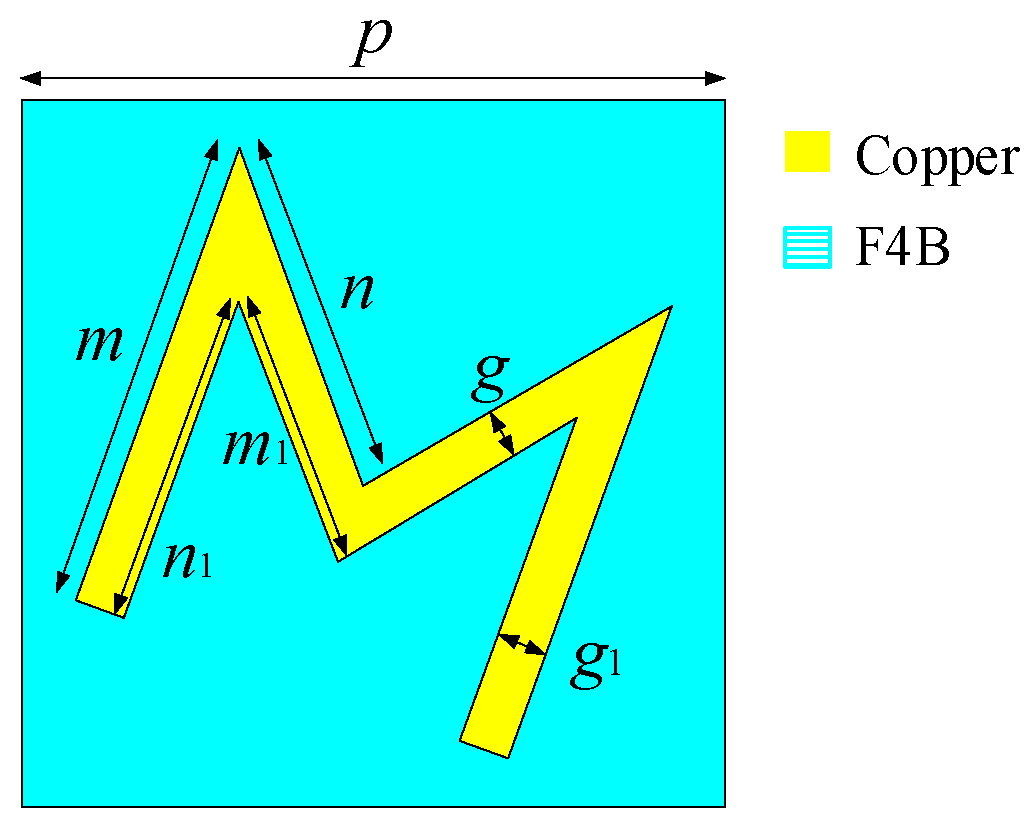
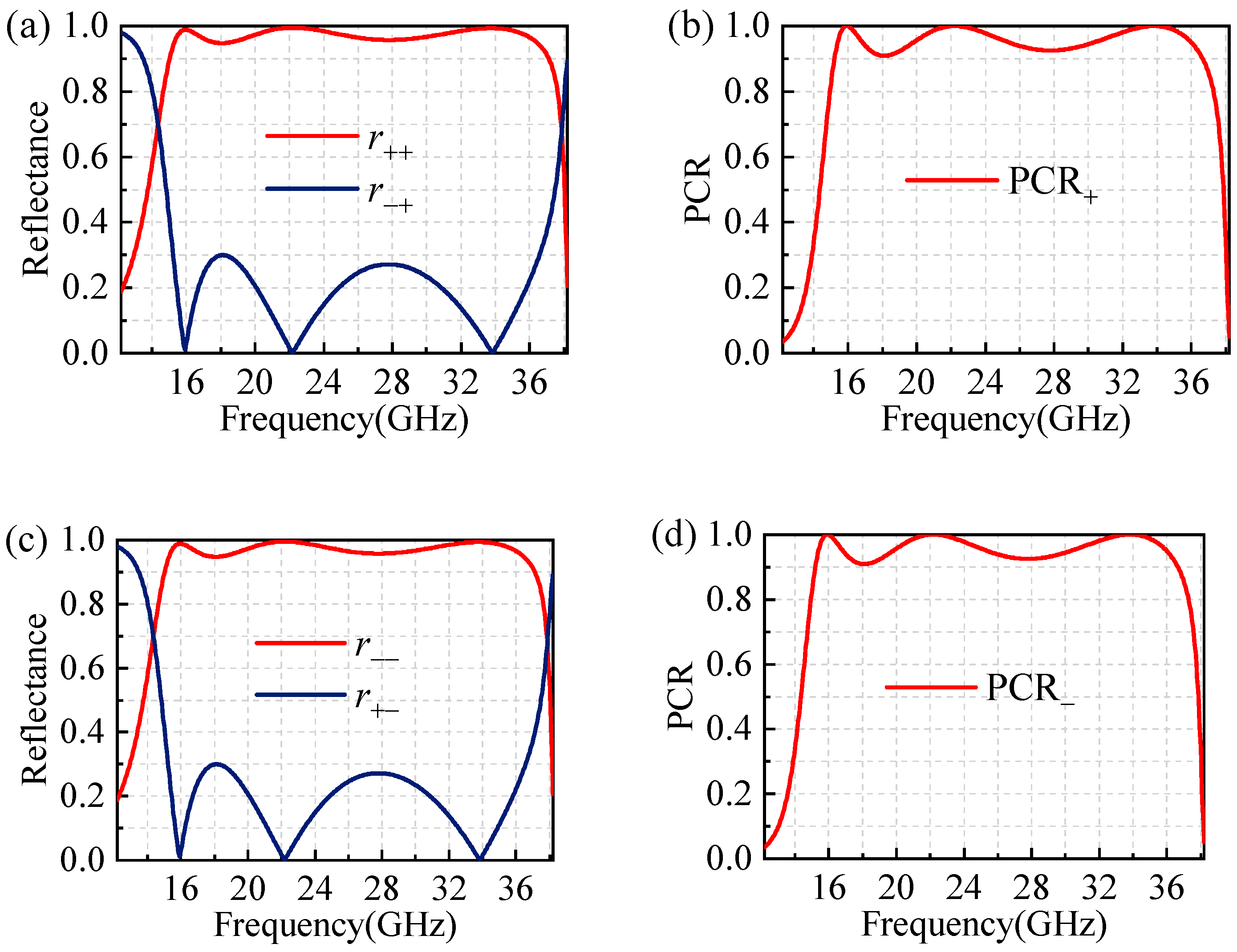



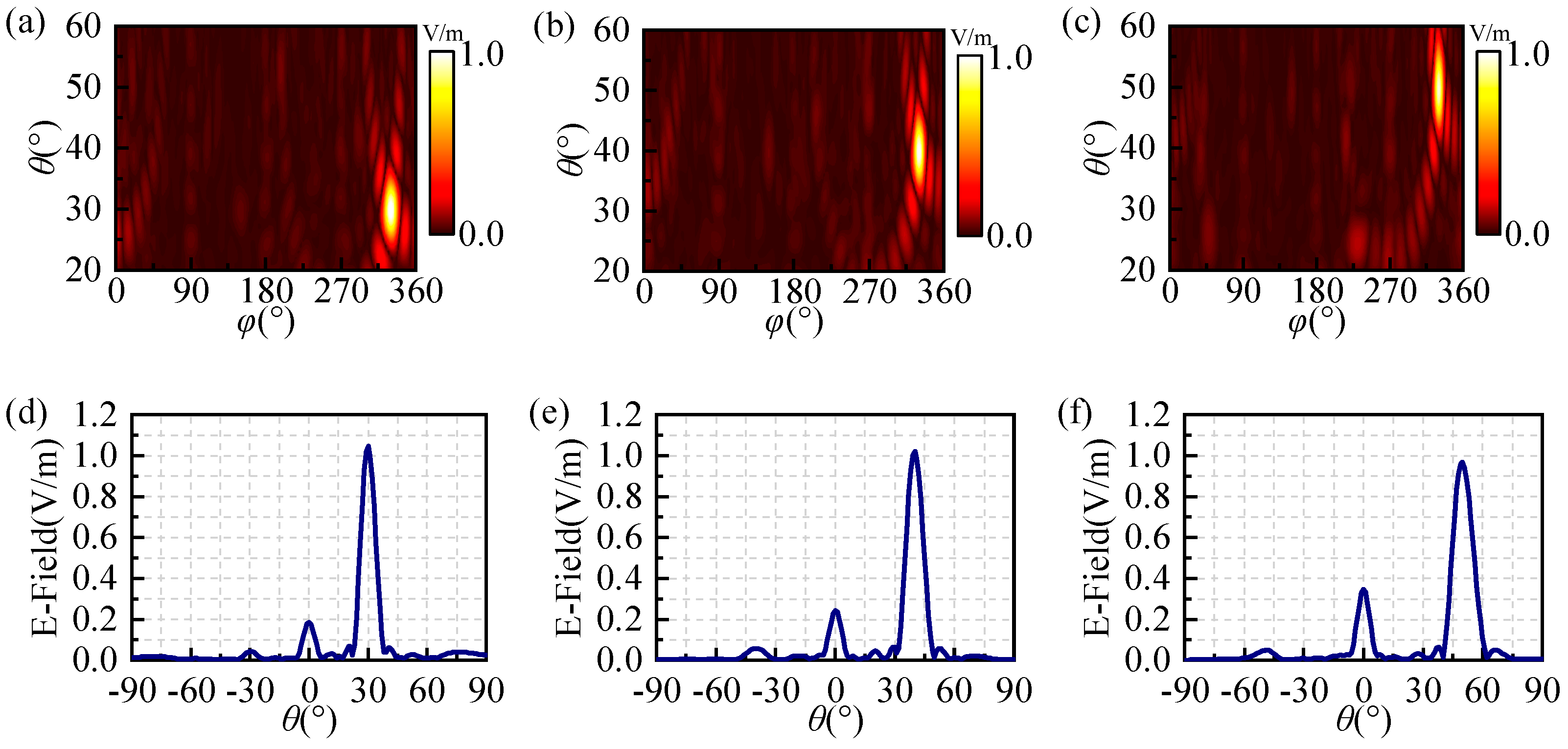

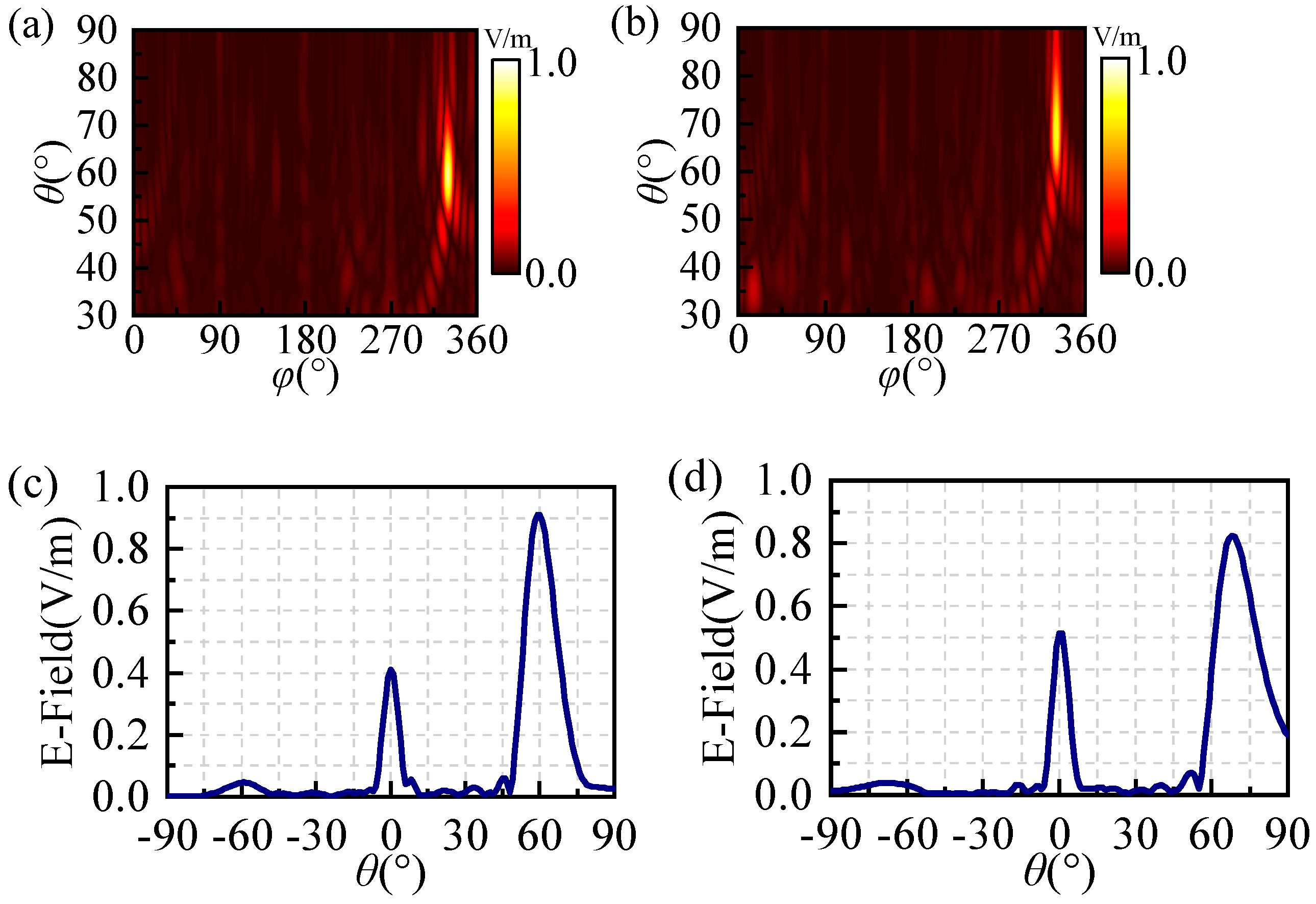
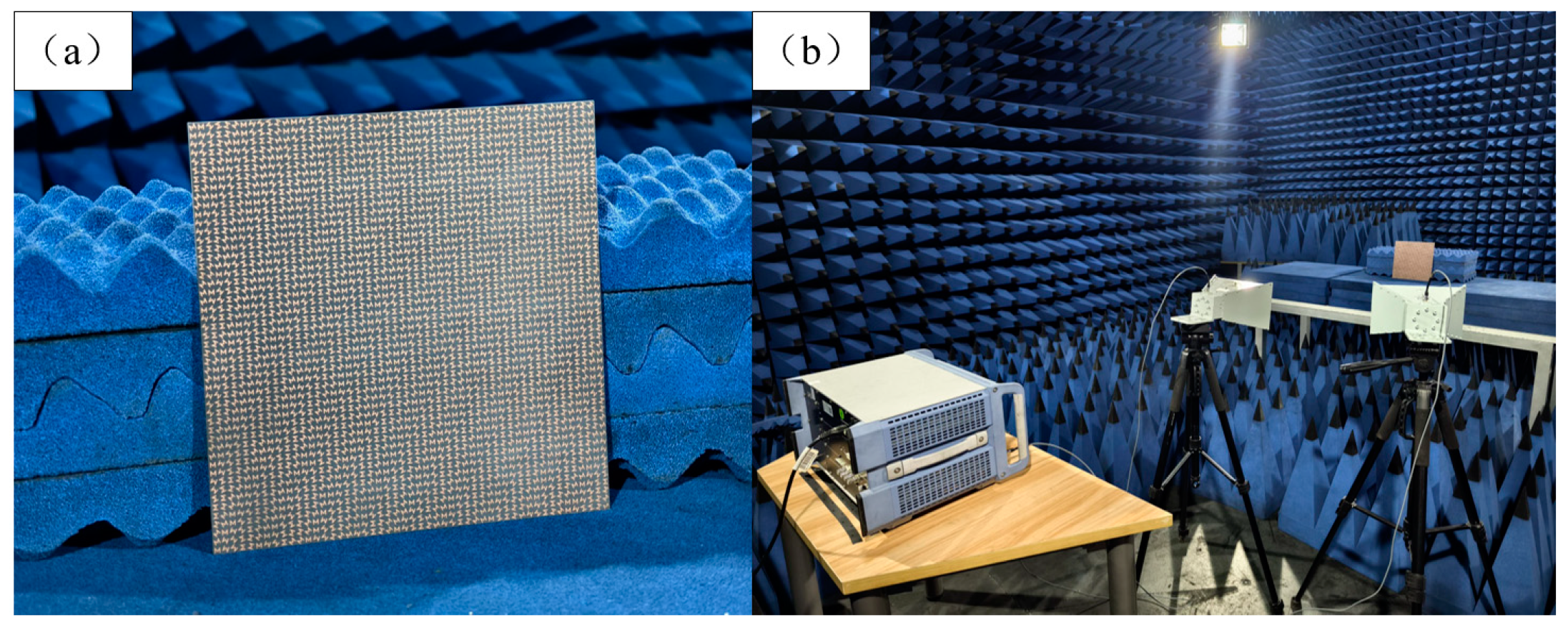

Disclaimer/Publisher’s Note: The statements, opinions and data contained in all publications are solely those of the individual author(s) and contributor(s) and not of MDPI and/or the editor(s). MDPI and/or the editor(s) disclaim responsibility for any injury to people or property resulting from any ideas, methods, instructions or products referred to in the content. |
© 2024 by the authors. Licensee MDPI, Basel, Switzerland. This article is an open access article distributed under the terms and conditions of the Creative Commons Attribution (CC BY) license (https://creativecommons.org/licenses/by/4.0/).
Share and Cite
Sun, C.; Gao, J.; Gao, H.; Ma, X.; Huang, X. A Low-Profile and Ultra-Wideband Pancharatnam–Berry Coding Metasurface for High-Efficiency and Wide-Angle Circular Polarization Anomalous Reflection. Materials 2024, 17, 4730. https://doi.org/10.3390/ma17194730
Sun C, Gao J, Gao H, Ma X, Huang X. A Low-Profile and Ultra-Wideband Pancharatnam–Berry Coding Metasurface for High-Efficiency and Wide-Angle Circular Polarization Anomalous Reflection. Materials. 2024; 17(19):4730. https://doi.org/10.3390/ma17194730
Chicago/Turabian StyleSun, Cuizhen, Junfei Gao, Huanhuan Gao, Xiongwei Ma, and Xiaojun Huang. 2024. "A Low-Profile and Ultra-Wideband Pancharatnam–Berry Coding Metasurface for High-Efficiency and Wide-Angle Circular Polarization Anomalous Reflection" Materials 17, no. 19: 4730. https://doi.org/10.3390/ma17194730
APA StyleSun, C., Gao, J., Gao, H., Ma, X., & Huang, X. (2024). A Low-Profile and Ultra-Wideband Pancharatnam–Berry Coding Metasurface for High-Efficiency and Wide-Angle Circular Polarization Anomalous Reflection. Materials, 17(19), 4730. https://doi.org/10.3390/ma17194730





